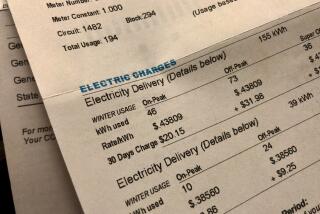SDG&E; Pushes Ahead With Diversification
- Share via
Even if state regulators disallow the holding company that San Diego Gas & Electric shareholders approved on Friday, the utility probably will continue to diversify beyond its traditional gas and electric businesses, according to both company officials and critics.
For example, the Utility Consumers’ Action Network (UCAN) “is not going to say that (SDG&E;) can’t diversify, because it’s going to happen,” acknowledged Michael Shames, executive director of UCAN, the San Diego-based organization with 54,000 members in SDG&E;’s service area. “The holding company, however, would allow them to diversify more quickly.”
“Why rush into it when so much is not known?” said Shames, who argued that the PUC should prohibit SDG&E; from forming a holding company. “Why give a blank check as opposed to a conditional check? There are so many major questions about diversification and its impacts on the marketplace, competitors and ratepayers (customers).”
Although the City of San Diego will not take a stand on SDG&E;’s holding company proposal until after the state Public Utilities Commission completes its hearings in San Francisco later this week, Deputy City Atty. William Shaffran noted that “SDG&E; is healthy as hell right now, which is fine. But now they want to go off in new directions.”
“Our basic interest is the possible effects on the consumers who are our constituents,” Shaffran said. “The benefits of a holding company type of (operation) are basically all shareholder benefits.”
“We are a premier utility and we will continue to get better,” SDG&E; President and Chairman Thomas Page told shareholders during a special meeting Friday. “We are not going to take our eye off of our primary business.”
Rather, Page said, the proposed holding company will give SDG&E; the “structural flexibility” to maintain “a more clearly defined separation of utility and non-utility operations.”
“It would be too bad” if the PUC voted to disallow the holding company, Page said last week. “If the commission says ‘no,’ we’d see about an appeal. But we’d still go ahead with diversification.”
Changes in the utility industry have force SDG&E; to re-position itself as “an energy management company,” said Page, who acknowledged that even the utility’s managers aren’t sure of the company’s future business makeup.
“The ‘utility company’ term is dead,” Page said. “The market has changed so substantially that (SDG&E;) must change.”
“The world is changing,” Shames agreed. “But utility and gas operations have to remain under PUC scrutiny. There’s no room for debate. The larger question, however, involves affiliates and non-regulated industries.”
During last week’s PUC hearings in San Francisco, SDG&E; officials promised to give PUC investigators total access to the holding company’s books, Shaffran said.
The utility also changed its dividend withholding plan last week. It told PUC members that instead of requiring utility managers to pass 100% of utility company dividends on to the holding company, they would be free to determine annual transfers to the holding company.
That arrangement “is much better except that you run into the problem that everywhere you turn, Tom Page is the top guy,” Shaffran said. “He is both CEO and chairman of the board for the holding company and CEO and chairman of the utility. And that’s a problem for us.”
Shaffran also suggested that the creation of a holding company could create a “brain drain” that would be costly to the utility if important executives “who helped execute SDG&E;’s turnaround disappear” into the holding company.
Shaffran and Shames suggested that, in addition to utility customers, independent energy producers--designated as “qualified facilities” in utility jargon--also stand to be hurt by SDG&E;’s diversification.
“The PUC commissioners at (the San Francisco) hearings seemed very concerned about protecting ratepayers,” Shames observed. “But there’s another thing--protecting the market, the qualifying facilities and other competitors” from SDG&E;, which because of its utility-generated revenues, could become a force in “everything from computers to real estate.”
“Some of the qualifying facilities are afraid of sweetheart deals” between the SDG&E; holding company and its subsidiaries, Shaffran said. He added: “So am I.”
Page promised shareholders last week that the utility business, which accounted for 98% of SDG&E;’s assets in 1984, will continue to represent more than 90% of company assets “for many years to come.”
However, in a corporate strategic plan that SDG&E; delivered to the PUC, the utility acknowledged that “financial analysts generally look for 15% to 25% of income to be derived from non-utility sources to consider a firm as (being) diversified.”
More to Read
Sign up for Essential California
The most important California stories and recommendations in your inbox every morning.
You may occasionally receive promotional content from the Los Angeles Times.













